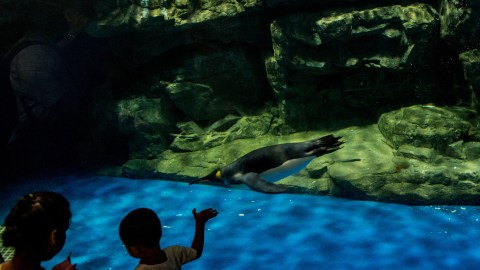What’s Worse for Animals than Zoos? Romantic Eco-Tourists.

Zoos are often advertised as a place of scientific education,where people can connect with nature through observation. What you’re really getting is entertainment — depressing, unnatural entertainment. I’d argue that BBC’s Planet Earth will give you a better connection with nature.Randy Malamud, on the other hand, would rather experience animals in their natural habitat.But while I commend his romantic piece in Salon, about the values of traveling to see animals in their own environment (and not patronizing zoos), the idea he’s spreading requires a big footnote on eco-tourism.
Malamud was fortunate enough to have the means and the opportunity to fly to the bottom of Argentina to see the most adorable animal on the planet: the penguins. His shared experience is quite moving, expressing how zoos tell a lie about nature that leaves us disconnected.

He writes: “There were so many of them — it was a community of penguins, a world of penguins, an ecosystem of penguins that surrounded me, as opposed to what an aquarium presents: a specimen, a sample of penguin. Even if there’s more than one penguin on display, it’s not much more: A few, or even a few dozen, fail to give any meaningful sense of what a real penguin colony is like. In zoos, signs might explain that penguins are highly social animals, but such information is a profoundly paltry approximation of actually being in their society.”
But what Malamud may not realize is that while the cage isn’t there, the human presence is a barrier of its own.

Scientist Iain Kerr, the CEO of the Ocean Alliance, would argue that the less an animal knows you’re there, the closer you’ll get to truly knowing them. His team found its invisibility cloak through the development of the Snotbot — a drone that collects whale snot. The Snotbot allows the team to observe and collect samples from a far-off distance while the whale goes about its day, undisturbed. This technology could provide a new baseline for samples, helping researchers know, for the first time, what human activities were stressing whales out and what activities weren’t.
Some destinations for animal tourism may not be equipped to offer the considerations necessary to protect the welfare of these animals. A human presence can alter interactions and even introduce new bacteria. Take Antarctica, for example: Because of a rise in tourism, researchers have found that humans are compromising the health of many of the penguins there. While tourism for the sake of visiting an animal up close and personal sounds like a cool spiritual experience, it may be at the cost of disrupting an entire animal population.
Malamud does seem to be aware of his impact and has taken strides to minimize it by making sure the eco-tour group he was with was small and sustainable. His group consisted of 20 people who “followed the rules and stayed on the paths,” he wrote. Also, he went into it with the mind that he was a guest, saying, “how careful [he] had to be not to mess up their world.”
Still, many will read his article romanticizing the idea of seeing penguins up close and personal. Some may even take the leap and decide to connect with nature and jet set off to meet the penguins. But if you really want to connect with nature and observe an animal as it should be, bring a good pair of binoculars.
Photo Credit: Chris McGrath / Getty Staff




